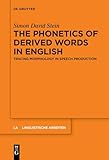The Phonetics of Derived Words in English : Tracing Morphology in Speech Production / Simon David Stein.
Material type: TextSeries: Linguistische Arbeiten ; 585Publisher: Berlin ; Boston : De Gruyter, [2022]Copyright date: ©2023Description: 1 online resource (XI, 227 p.)Content type:
TextSeries: Linguistische Arbeiten ; 585Publisher: Berlin ; Boston : De Gruyter, [2022]Copyright date: ©2023Description: 1 online resource (XI, 227 p.)Content type: - 9783111023519
- 9783111025780
- 9783111025476
- 425.92 23/eng/20230103
- online - DeGruyter
- Issued also in print.
| Item type | Current library | Call number | URL | Status | Notes | Barcode | |
|---|---|---|---|---|---|---|---|
 eBook
eBook
|
Biblioteca "Angelicum" Pont. Univ. S.Tommaso d'Aquino Nuvola online | online - DeGruyter (Browse shelf(Opens below)) | Online access | Not for loan (Accesso limitato) | Accesso per gli utenti autorizzati / Access for authorized users | (dgr)9783111025476 |
Browsing Biblioteca "Angelicum" Pont. Univ. S.Tommaso d'Aquino shelves, Shelving location: Nuvola online Close shelf browser (Hides shelf browser)
Diss. Uni Düsseldorf 2022.
Frontmatter -- Contents -- Acknowledgements -- List of figures -- List of tables -- 1 Introduction -- 2 Storing and processing derived words -- 3 General method -- 4 Frequency measures -- 5 Prosodic word integration -- 6 Affix informativeness -- 7 Linear discriminative learning -- 8 General discussion -- 9 Conclusion -- References -- Index
restricted access online access with authorization star
http://purl.org/coar/access_right/c_16ec
Effects of morphological structure on phonetic detail present us with two challenges. The empirical challenge is that some predictors have produced inconsistent effects. The theoretical challenge is that it is unclear where morpho-phonetic effects originate from. Do speakers decompose words into morphemes? Or can such effects also originate from non-decompositional structure? This book investigates the durational properties of English derived words in four large-scale corpus studies. In the decompositional perspective, durations are modeled as a function of frequency and segmentability, prosodic structure, and affix informativeness. In the non-decompositional perspective, durations are modeled with predictors derived from linear discriminative learning networks. Results show that the decompositional predictors are far less reliable than previously thought. Meanwhile, some non-decompositional predictors model durations successfully. Discriminative learning is shown to be a promising alternative for modeling speech production. However, the book also demonstrates that many investigated predictors are conceptually interrelated. It ultimately cautions against taking the metaphors we use to describe these predictors as final explanations.
Issued also in print.
Mode of access: Internet via World Wide Web.
In English.
Description based on online resource; title from PDF title page (publisher's Web site, viewed 25. Jun 2024)









